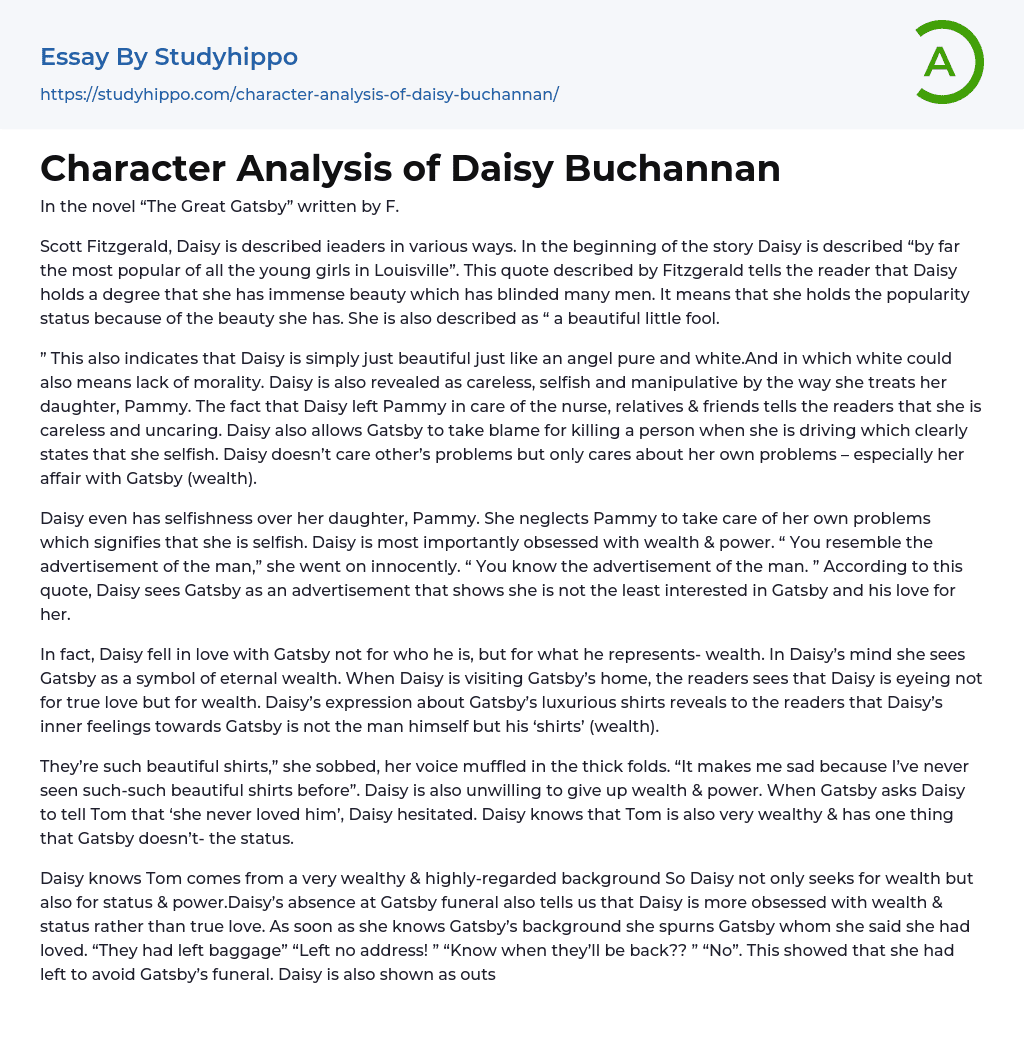Written by F. Scott Fitzgerald, "The Great Gatsby" is a novel.
Within Scott Fitzgerald's narrative, Daisy is portrayed as a leader through various descriptions. At the start of the tale, Daisy is labeled as "by far the most popular of all the young girls in Louisville," indicating that her exceptional beauty has dazzled many men and established her as a figure of great social standing. Fitzgerald also characterizes her as "a beautiful little fool."
The statement highlights Daisy's angelic beauty and purity, which could also suggest a lack of morality. Nevertheless, Daisy is characterized as neglectful, self-centered, and manipulative for how she treats her daughter Pammy. The fact that she left Pammy in the care of nurses, relatives, and friends depicts her as uncaring and heedless. Furthermore, when Daisy is driving and involved in an accident, she lets Gatsby assume resp
...onsibility, clearly revealing her selfishness. She prioritizes her concerns only- particularly her affair with the wealthy Gatsby- rather than worrying about others' issues.
It is true that Daisy's love for Gatsby stems more from what he represents- wealth- rather than his true character. To Daisy, Gatsby serves as a symbol of perpetual prosperity. Even in her visit to Gatsby's abode, it becomes apparent that Daisy's interest is not centered on genuine love but monetary gain. The way she comments on Gatsby's opulent shirts exposes he
true sentiments towards him: her attraction lies not in the man but in his abundance.
The exquisite shirts made her cry, her words muffled by their thickness, as she lamented never having seen such beauty before. Daisy clung to her wealth and power, hesitating when Gatsby asked her to tell Tom she never loved him. She recognized that Tom possessed something Gatsby lacked: high social standing, in addition to great wealth.
Daisy desires both wealth and status, as evident by her knowledge of Tom's prestigious background. Her absence at Gatsby's funeral suggests her obsession with wealth and status as opposed to true love. Daisy displays her disregard for Gatsby after learning about his background, dismissing him despite her previous claims of love. Her departure from the funeral displayed a lack of interest. Additionally, Daisy is outspoken, telling Gatsby that he wants too much despite her professed love for him not being enough. "They had left baggage," "Left no address," and "Know when they'll be back??" demonstrated her avoidance of the funeral.
F. Scott Fitzgerald employs the flower "Daisy" as a representation throughout the book. The flower mirrors Daisy's character as she is a stunning yellow flower. Her beauty is comparable to that of the flower, and her personality reflects its yellow color. This color signifies affluence, however, it can also allude to conceit and lack of integrity.
In the novel, Daisy is portrayed as a gorgeous, spoiled, and free-spirited girl, modeled after Zelda Fitzgerald. According to Fitzgerald, she is solely driven by her obsession with riches and authority.
- First person essays
- American Literature essays
- Between The World and Me essays
- Book Report essays
- Book Review essays
- Book Summary essays
- Books essays
- Character essays
- Coming of Age essays
- Dante's Inferno essays
- Everyday Use essays
- Flowers for Algernon essays
- Genre essays
- Greek Mythology essays
- Incidents in The Life of a Slave Girl essays
- Letter essays
- Literary Criticism essays
- Literary devices essays
- Literature Review essays
- Metaphor essays
- Myth essays
- Play essays
- Plot essays
- Poem essays
- Poetry Analysis essays
- Protagonist essays
- Reader essays
- Reason essays
- Rhetoric essays
- Rhetorical Question essays
- Rhyme essays
- Simile essays
- Tragic Hero essays
- Translation essays
- Understanding essays
- Utopia essays
- Villain essays
- Writer essays
- Aldous Huxley essays
- Alice Walker essays
- Amy tan essays
- Anne Bradstreet essays
- Anton Chekhov essays
- Arthur Miller essays
- Augustine essays
- Bertolt Brecht essays
- Booker T Washington essays
- Carol ann duffy essays
- Charles Dickens essays
- Charlotte Perkins Gilman essays




